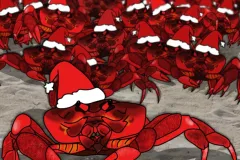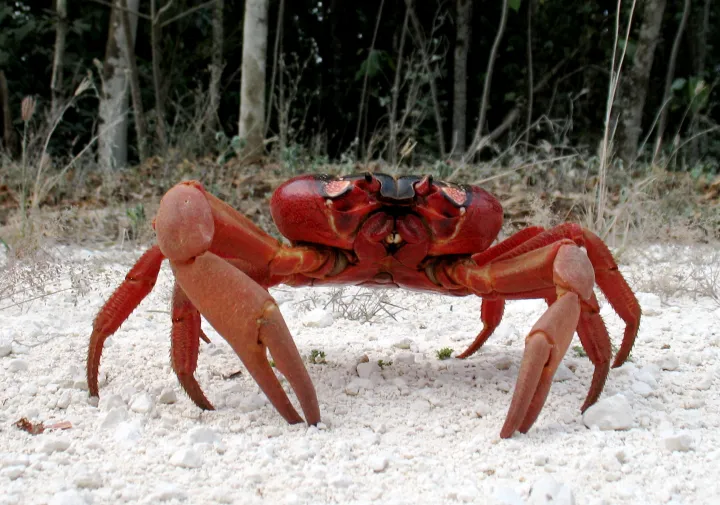Here Comes Santa Claws

Santa isn’t the only long-distance traveler in a red suit—at the beginning of their wet season, the Christmas Island red crab (Gecarcoidea natalis) makes an impressive annual migration across Christmas Island, an island named for the day it was discovered in 1643.
Around 44 million Gecarcoidea natalis are endemic to the island in the Indian Ocean. These solitary crabs are spread out over 135 square kilometers (52 square miles) and seek refuge in rain forests where there’s high humidity.
Each crab lives in its own burrow, and must avoid being caught under direct sunlight for extended periods of time. Such exposure can kill a crab that must maintain its body moisture above certain levels. Dry season on the island, around the middle of the year, forces the crabs to remain in their burrows for up to several months, while sealing themselves (and the humidity) in with leaves at the entrance.
As the yearly monsoons approach (beginning around November), the air becomes moist, allowing the crabs to travel farther without losing much needed body moisture.
At this point, any sexually mature crab (around four years of age and up) will partake in a long migration to the coast to spawn. Famed naturalist and TV host Sir David Attenborough has called it one of the greatest wildlife spectacles. The sheer number of crabs crossing the island has made this one of the most famous animal migrations.
Male crabs leave first, traveling over 4 kilometers (2.5 miles) and taking between 5 and 7 days depending on where their burrows are on the island. Upon arrival, they return to the sea to gain back the moisture they lost during the long journey, and then begin to dig densely packed burrows.
A few days later, adult females arrive to mate with males in their burrows, after which the males return inland and the females stay a couple of weeks to lay their eggs, incubating them in their abdominal brood pouch as they develop.
Spawning is highly correlated with the lunar cycle and can happen anytime between September and January. Female crabs wait until the last quarter of the moon, when there is little difference between low and high tide, to line up at the edge of the water and release their eggs into the ocean.
The crab eggs hatch in the water, but many will be snatched up and eaten by fish. After a month, those that do survive develop into small crabs, which then make the journey back into the forest.
But even this story isn’t without a Grinch. The yellow crazy ant (Anoplolepis gracilipes), named for its color and “crazy” gesticulation when provoked, has taken a massive toll on the Christmas Island crab population.
This invasive ant builds supercolonies with astounding densities of 2,000 ants per square meter. Not only do these ants take over land previously used by the crabs, but also eat the crabs themselves.
The ants are opportunists, consuming a variety of things from honeydew melon to invertebrates and small vertebrates. Their weapon of choice? Formic acid. The ants spray other animals with it, blinding and then killing them within a few hours.
As a result, crab numbers are declining, which is a big problem for the ecology of the rainforest. The forest depends on crabs for several “presents”: the turnover of soil while building burrows, the dispersal of seeds from their diet, and the fertilization of the soil from the crab’s droppings.
Rest assured, there may be a Christmas miracle to this story after all. Mick Jeffery, manager of the Christmas Island National Park commented via The Telegraph that “good progress” is being made to control the invasive ants and that targeted ant-baiting has helped keep crab populations stable over a number of years.
This post first appeared on the Smithsonian's National Museum of Natural History, Department of Invertebrate Zoology "No Bones" Blog. Written by Maria Robles Gonzalez and edited by Liz Boatman.


